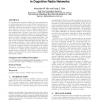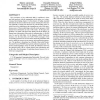MOBICOM
2009
ACM
14 years 6 months ago
2009
ACM
In cognitive radio networks (CRNs), spectrum sensing is key to opportunistic spectrum access while preventing any unacceptable interference to primary users’ communications. Alt...
MOBICOM
2009
ACM
14 years 6 months ago
2009
ACM
In November 2008, the FCC ruled that the digital TV whitespaces be used for unlicensed access. This is an exciting development because DTV whitespaces are in the low frequency ran...
MOBICOM
2009
ACM
14 years 6 months ago
2009
ACM
We consider the problem of efficient link-layer multicasting in wireless networks with switched beamforming antennas. The inherent tradeoff between multicasting and beamforming �...
MOBICOM
2009
ACM
14 years 6 months ago
2009
ACM
The coexistence of two unlicensed links is considered, where one link interferes with the transmission of the other, over a timevarying, block-fading channel. In the absence of fa...
MOBICOM
2009
ACM
14 years 6 months ago
2009
ACM
In this paper we investigate the connectivity for large-scale clustered wireless sensor and ad hoc networks. We study the effect of mobility on the critical transmission range fo...
MOBICOM
2009
ACM
14 years 6 months ago
2009
ACM
Cognitive relays form a special cooperation relationship among users in cognitive radio networks, and help increase the transmission rates of both primary users and secondary user...
MOBICOM
2009
ACM
14 years 6 months ago
2009
ACM
This paper describes an unconventional way to apply wireless networking in emerging technologies. It makes the case for using a two-tier hybrid wireless/wired architecture to inte...
MOBICOM
2009
ACM
14 years 6 months ago
2009
ACM
Establishing a control channel for medium access control is a challenging problem in multi-channel and dynamic spectrum access (DSA) networks. In the design of multi-channel MAC p...
MOBICOM
2009
ACM
14 years 6 months ago
2009
ACM
The capacity scaling property specifies the changes in network throughput when network size increases and serves as an essential performance evaluation metric for large-scale wir...


